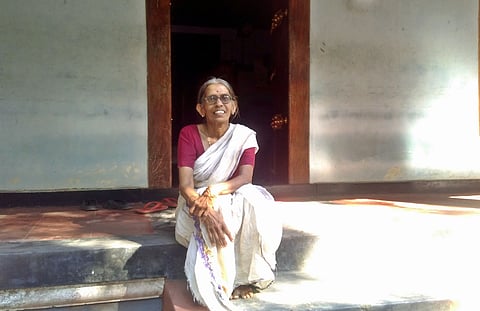Inside Kerala’s Ullannoor Mana, an ayurvedic centre which ‘heals’ snake bites
The air is heavy with the weight of tradition in the Ullannoor Mana in Kerala’s Thrissur district. While the three-storied building with red oxide floors and wide pillars is 300 years old, Ullannoor Mana in Mecherippadi has had the distinction of providing ayurvedic healing for snake bites; i.e. Visha Chikitsa for four decades.
Vimala came to Mercherippadi after she got married to Trivikraman Namboothiri who brought her to Ullannoor Mana in 1975. Even after her wedding, she continued to do what she did in her parents’ house – heal people – thereby starting the healing tradition in the Mana. Vimala began learning methods of healing the effects of venom from her father VM Sankaran Namboothiri at their home in Palakkad.
Now 67 years old, Vimala continues to help people who approach the Mana along with her son Brahmadattan, irrespective of caste and creed. On average, they treat around 10 people with snake bites, scorpion bites and certain ailments on a daily basis.
“The course of treatment is not based on the type of venom or the type of snake, but depending on the kind of reaction it has on the patient’s body”. The treatment may either be one-time administration, or may run into weeks, and which is to be observed with care.
Besides healing, dealing with skeptics who say they have no business risking the lives of people also occupies some amount of their time.

Ullannoor Mana
In 2003, the Mana was at the centre of a controversy when 11-year-old Fatima, who was brought to Vimala died, allegedly due to treatment by the Mana.
There are multiple versions of what happened to the child. One version says that the child was brought to Vimala after she was declared dead by hospital authorities.
The day before, Fatima had been treated by Vimala but had failed to follow the prescribed diet, after which she was admitted to a nearby hospital. After the hospital declared her dead, her parents brought her to Vimala again, who claimed that the child started showing signs of life again. However, she went into coma and died a few days later.
This case evoked criticism from doctors who said that the “unscientific treatment” had resulted in Fatima’s death.
Mulamkunnathkavu Medical College Superintendent Dr Praveen Lal had lodged a complaint with the Kerala State Human Rights Commission over her death.
Ullannoor Mana is not registered as an ayurveda clinic.
Despite this, others have faith in Vimala and the treatment she provides. Sulochana Damodaran, a resident of Pavaratty, still remembers the time when poisonous liquid from a plant caused white spots to appear on her hand.
“If it is a poison-related case, the best option is to approach the Mana. Even when other methods of treatment fail, we trust the treatment given at the Mana,” she said.
When The News Minute visited Vimala, Brahmadattan was teaching three students in an outhouse located on the eight-acre premises of the Mana. He was teaching them what he learned from his mother. His voice carried over the silence that was only broken by the chirping of birds and the rustling leaves.
“Currently, eight doctors are here to learn. The teaching period varies from person to person, some come for 3 months, whereas some others stay for a year. The learning is a continuous process,” Vimala Thamburatti says.

